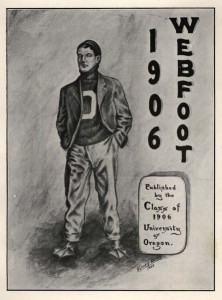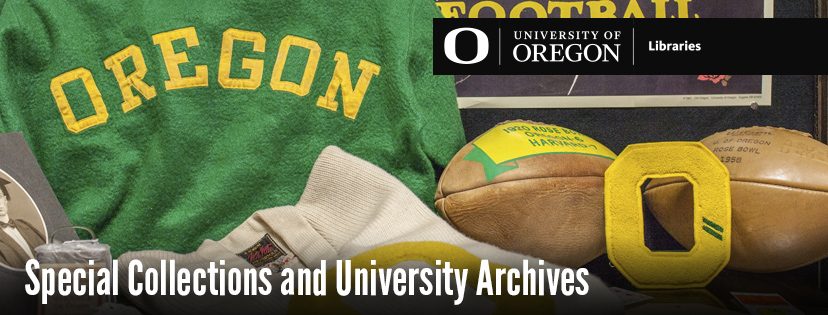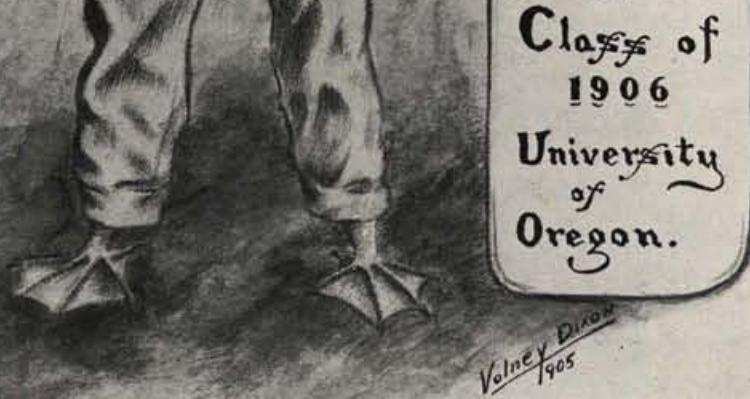The Oregon Mascot, Part 1: The Webfooter Years
This two-part series utilizes archival sources in the UO Special Collections and University Archives to show the long and contentious history of athletic mascots on the Eugene campus.
When the University of Oregon played its first football game in the spring of 1894, there was not a mascot patrolling the sideline and inciting crowd participation. The UO team that played Albany College was known only as the “lemon yellow,” referring to the accent color of their uniforms. When the team returned to the field for three games in the fall, there was still no defining mascot for the team. For three decades after that first season, the school would have no official representative for its sports teams, and it would take another half-century before Oregon became the Oregon Ducks. Instead UO would come to be known by an obscure east-coast reference turned pejorative turned source of pride — the Webfoot.
 The path toward inheriting the Webfoot moniker began the week before the Thanksgiving 1894 game against Pacific University. In its preview of the last game of the inaugural season of UO football, the Eugene Guard used the term to describe the team for the first time:
The path toward inheriting the Webfoot moniker began the week before the Thanksgiving 1894 game against Pacific University. In its preview of the last game of the inaugural season of UO football, the Eugene Guard used the term to describe the team for the first time:
“The grounds will be somewhat muddy tomorrow, but that never stops an enthusiastic football player. In fact Webfoot boys would rather play on a muddy field than on one that is dry and solid.”
The nickname, however, was not a synonym for a duck. It was rather a term that had originated in Massachusetts during the 1700s to describe locals who lived in wet conditions. The term was proliferated by miners coming northward from California as a pejorative descriptor of the locals of the waterlogged Willamette Valley and had grown in popular usage by the 1860s. By the time the University of Oregon began forming sports teams for intercollegiate play in the last decade of the 19th century, the term Webfoot had become synonymous with Oregonians.
 During that first decade of varsity sports organization, Webfoot was increasingly used by the student body on the Eugene campus and sports journalists in the state to describe the UO teams. The school first used the name Webfoot for itself in any official capacity in 1902, when the inaugural yearbook received the name as its title.
During that first decade of varsity sports organization, Webfoot was increasingly used by the student body on the Eugene campus and sports journalists in the state to describe the UO teams. The school first used the name Webfoot for itself in any official capacity in 1902, when the inaugural yearbook received the name as its title.
That, however, did not end the debate surrounding the mascot question. By 1907 statewide sentiment had turned sour toward the term Webfoot, and the 1907 yearbook would adopt the startling name “The Beaver”. Through the first two decades of the 20th century, there remained no officially sanctioned mascot for the university. Even as the use of mascots became commonplace at universities around the country, the Oregon teams that went to the Rose Bowl twice in four years after the 1916 and 1919 seasons traveled to Pasadena without one of their own to cheer them on.
The word “Web-foot” made its reappearance in print in January 1922 thanks to Oregon Daily Emerald reporter Ep Hoyt, who bestowed the name upon the UO football team during its postseason tour of Hawaii. Later that year, an Emerald editorial argued for the necessity of adopting a team name for UO sports teams and solicited names from readers. Professor W.G. Thatcher argued in favor of Pioneers, while other suggestions included Condors, Eagles, Hawks, Vultures, Bulls, Wild Cats, and Fighting Drakes. Another professor, Jim Gilbert, favored Skinners in tribute to the founder of Eugene.
The debate surrounding the adoption of an official mascot raged for five years from 1922 to 1926. UO president Prince Lucien Campbell and key aide Karl Onthank were steadfastly against bestowing any name upon the school’s athletic teams, thinking it would negatively affect school branding. As the campus and the city of Eugene debated the choices, newspapers around the state increased the frequency with which they used Webfoot to describe the Oregon teams. When the Daily Emerald named its new campus publication Webfoot, it justified the choice by stating that the decision was due to the fact that “Oregon athletic teams are known throughout the country as the ‘Webfooters’.”
On November 6, 1926, the Eugene Guard and Oregon Daily Emerald jointly announced a new naming contest for the University of Oregon’s sports teams. Webfoots and Ducks were viewed as “inadequate names” that impute “the harmlessness of doves” on the school’s squads. A new round of submissions was soon published by the two newspapers. ODE sports editor Harold Mangum, who was also a substitute tackle on the football team, suggested Gorillas after his own nickname. Other names under consideration included Pioneers, Trappers, Trailers, and Blazers in honor of the valley’s early settlers.
By November 17, the three finalists were named: Dragons, Vikings, or Webfeet. The first two names were the popular finalists, though both the SalemCapital Journal and Eugene Guard started touting Webfeet as a source of local pride. Six days later, the modified term Webfoots was adopted after it was proposed by Portland Oregonian sports editor L.H. Gregory. The journalist won a duck after his suggestion was selected.
But the newspaper contest did not end the debate. It wouldn’t be until 1932 that students and alumni voted to confirm Webfoots as the official school mascot. The poll also included such names as Trappers, Pioneers, Lumberjacks, and Yellow Jackets, but decades of popular usage had ingrained the Webfoot brand onto the university. 38 years after the first teams took to the field for the University of Oregon, the school had finally embraced the brand which had been organically bestowed upon its teams over the previous decades.
Continue to Part 2 of our look at the Oregon mascot.
Information for this article was collected from the following sources:
- Douglas Card, “The Webfooted Ducks” (unpublished paper, UO Special Collections and University Archives, 1992).
- Paul Caputo, “Getting Our Webfeet in a Row: The Story Behind the Oregon Ducks,” SportsLogos.net, Sept. 27, 2014.
- “Ducks??? To the old-guard alumni, it’ll always be the Webfoots,” Eugene Register-Guard, Feb. 29, 1976.
- Photos sourced from the UO Archives Digital Photo Collection and the University of Oregon Yearbooks Archive.
Zach Bigalke
Student Research Assistant


